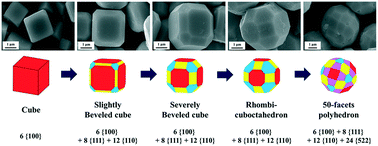Evolution of the morphology of Cu2O microcrystals: cube to 50-facet polyhedron through beveled cube and rhombicuboctahedron†
Abstract
We present a simple morphology-controlled method for the synthesis of Cu2O microcrystals. The Cu2O microcrystals are prepared via the reduction of copper with glucose in an alkaline aqueous solution. The concentration of NaOH plays an important role in the morphology evolution of the resulting microcrystals. We observed the evolution of the morphology of the Cu2O microcrystals, which changes from a cube to a beveled cube and then to a rhombicuboctahedron and a 50-facet polyhedron upon the increase in the NaOH concentration. A mechanism is proposed to explain the evolution of the morphology of Cu2O.



 Please wait while we load your content...
Please wait while we load your content...